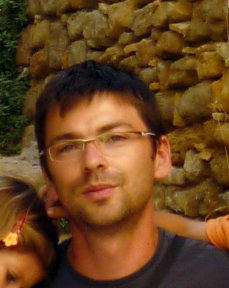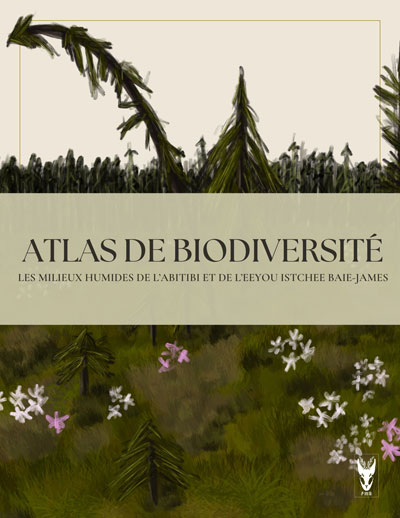
Frank Berninger
Membre associé
Écologie
Professor
Department of Environmental and Biological Sciences
Joensuu campus
University of Easter Finland
FORMATION
- Ph.D. en écologie forestière, 1997 (Université de Helsinki, Finlande)
- M.Sc. en silviculture, 1991 (Université de Helsinki, Finlande)
BIOGRAPHIE
Frank Berninger est actuellement professeur en écologie végétale à la University of Easter Finland. Il a été titulaire de la chaire de recherche du Canada en productivité forestière ![]() jusqu'en 2010. Il a aussi été membre du réseau stratégique CRSNG sur l'aménagement forestier pour les produits ajoutés
jusqu'en 2010. Il a aussi été membre du réseau stratégique CRSNG sur l'aménagement forestier pour les produits ajoutés ![]() (ForetValeur). Il a travaillé dans les écosystèmes boréaux en Finlande et tropicaux au Costa Rica. Il intègre des travaux écophysiologiques considérant la physiologie de la plante entière couplée à la productivité forestière (à travers des modèles de croissance).
(ForetValeur). Il a travaillé dans les écosystèmes boréaux en Finlande et tropicaux au Costa Rica. Il intègre des travaux écophysiologiques considérant la physiologie de la plante entière couplée à la productivité forestière (à travers des modèles de croissance).
THÈMES DE RECHERCHE
Interactions hydriques
Les interactions hydriques des arbres sont un de ses thèmes de recherche favoris. Un hectare de forêt transpire facilement 80 000 kg d’eau dans une journée chaude. Pour utiliser l’eau les arbres doivent la prélever du sol avec des milliers et des milliers de petites racines et la transporter aux feuilles 10-30 m plus haut. Le transport se déroule à travers un gradient de tensions d’eau (des pressions négatives) qui sont assez fortes (qui peuvent facilement atteindre moins de -10 bars). Ce n’est pas une surprise que le transport de l’eau pose des contraintes importantes à la structure de l’arbre entier. En plus la transpiration et la production photosynthétique sont liées et des réductions dans la transpiration signifient aussi des réductions dans la productivité des arbres.
Le Dr. Berninger s’intéresse aux processus permettant aux arbres de transporter de l’eau qu’ils puisent dans le sol vers les feuilles situées plusieurs mètres en hauteur. Ce transport régule la transpiration/photosynthèse et dépend de la physiologie et la morphologie des structures d’apport d’eau (racines, tronc et branches). Parce que la capacité de transporter l’eau aux feuilles et la consommation d’eau doivent être en équilibre. La façon dont les arbres maintiennent cet équilibre influence la croissance des forêts. Grâce à des modèles de croissance, il tente d’estimer les effets de différentes stratégies sur la croissance totale des arbres ou des forêts.
Variations interannuelles de la production des arbres
Le Dr. Berninger tente de comprendre d’une manière physiologique comment le climat et la productivité des arbres (mesurée par la largeur des cernes de croissance) sont liés. En effet, les variations climatiques introduisent des variations dans la production photosynthétique, le cycle des nutriments et donc la croissance des arbres. Particulièrement les températures au printemps et la longueur de la période de croissance de la végétation semblent importantes.
Le travail sur les cernes se fait principalement par des modèles de croissance, mais aussi à l’aide de mesures sur le terrain pour paramétrer les modèles et comprendre les processus impliqués.
Il utilise aussi les variations des isotopes naturels pour comprendre et interpréter les cernes de croissance. L’eau est aussi un aspect important dans ce travail, dans un projet avec Hydro-Québec en essayant de modéliser la transpiration des arbres à partir des cernes et de mieux comprendre les apports des réservoirs hydriques dans le nord du Québec.
Vous pouvez télécharger toutes mes références bibliographiques en format BibTeX, BibTeX-CSV, FRQNT ou EndNote
PUBLICATIONS
Livres
Invalid BibTeX File List (ChangHuiPengPub does not exists)!
Chapitres de livre
- Delagrange, S., Berninger, F. (2006) Une bouffée d’air frais. In L'écologie en ville : 25 leçons d'écologie de terrain. (Messier, C., Giraldeau, L.-A. and Beisner, B., Eds.) Montréal, QC, Canada, Fides, pages 16-23
- Messier, C., Delagrange, S., Berninger, F. (2006) L'arbre comme un aqueduc: La gestion de l'eau, des racines aux feuilles. In L'écologie en ville : 25 leçons d'écologie de terrain. (Messier, C., Giraldeau, L.-A. and Beisner, B., Eds.) Montréal, QC, Canada, Fides
Livres, numéros spéciaux et actes de colloques publiés à titre d'éditeur
Aucun
Articles révisés par un comité de lecture
- Goudiaby, V., Schneider, R., Brais, S., Raulier, F., Berninger, F. (2022) Understanding effects of competition and shade tolerance on carbon allocation with a carbon balance model. Forests, 13(4):572
- Palviainen, M., Lauren, A., Pumpanen, J., Bergeron, Y., Bond-Lamberty, B., Larjavaara, M., Kashian, D. M., Koster, K., Prokushkin, A., Chen, H. Y. H. et al. (2020) Decadal-Scale Recovery of Carbon Stocks After Wildfires Throughout the Boreal Forests. Global Biogeochemical Cycles, 34(8):e2020GB006612
- Baral, S.K., Berninger, F., Schneider, R., Pothier, D. (2017) Effects of heartwood formation on sugar maple (Acer saccharum Marshall) discoloured wood proportion. Trees - Structure and Function, 31(1):105-114
- Power, H., Franceschini, T., Schneider, R., Duchesne, I., Berninger, F. (2016) Crown characteristics slightly improve lumber mechanical property models for black spruce (Picea mariana (Mill.) BSP). Forestry Chronicle, 92(02):245-253
- Dhital, N., Raulier, F., Bernier, P.Y., Lapointe-Garant M.-P., Berninger, F., Bergeron, Y. (2015) Adaptation potential of ecosystem-based management to climate change in the eastern Canadian boreal forest. Journal of Environmental Planning and Management, 58(12):2228-2249
- Atlaskina, K., Berninger, F., de Leeuw, G. (2015) Satellite observations of changes in snow-covered land surface albedo during spring in the Northern Hemisphere. The Cryosphere, 9(5):1879-1893
- Power, H., Schneider, R., Berninger, F. (2014) Understanding changes in black (Picea mariana) and white spruce (Picea glauca) foliage biomass and leaf area characteristics. Trees - Structure and Function, 28(2):345-357
- Gewehr, S., Drobyshev, I., Berninger, F., Bergeron, Y. (2014) Soil characteristics mediate the distribution and response of boreal trees to climatic variability. Canadian Journal of Forest Research, 44:487-498
- Gea-Izquierdo, G., Bergeron, Y., Huang, J.-G., Lapointe-Garant, M.-P., Grace, J., Berninger, F. (2014) The relationship between productivity and tree-ring growth in boreal coniferous forests. Boreal Environment Research, 19(5-6):363-378
- Baral, S.K., Schneider, R., Pothier, D., Berninger, F. (2013) Predicting sugar maple (Acer saccharum) discoloured wood characteristics. Canadian Journal of Forest Research, 43(7):649-657
- Drobyshev, I., Gewehr, S., Berninger, F., Bergeron, Y. (2013) Species specific growth responses of black spruce and trembling aspen may enhance resilience of boreal forest to climate change. Journal of Ecology, 101(1):231-242
- Huang, J.-G., Bergeron, Y., Berninger, F., Zhai, L., Tardif, J.C., Denneler, B. (2013) Impact of Future Climate on Radial Growth of Four Major Boreal Tree Species in the Eastern Canadian Boreal Forest. PLOS ONE, 8(2):e56758-
- Zhai, L., Bergeron, Y., Huang, J.G., Berninger, F. (2012) Variation in intra-annual wood formation, and foliage and shoot development of three major Canadian boreal tree species. American Journal of Botany, 99(5):827-837
- Schneider, R., Fortin, M., Berninger, F., Ung, C.H., Swift, D.E., Zhang, S.Y. (2011) Modeling Jack Pine (Pinus banksiana) Foliage Density Distribution. Forest Science, 57(3):180-188
- Schneider, R., Berninger, F., Ung, C.H., Makela, A., Swift, D.E., Zhang, S.Y. (2011) Within crown variation in the relationship between foliage biomass and sapwood area in jack pine. Tree Physiology, 31(1):22-29
- Coll, L., Schneider, R., Berninger, F., Domenicano, S., Messier, C. (2011) Quantifying the effect of nitrogen-induced physiological and structural changes on poplar growth using a carbon-balance model. Tree Physiology, 31(4):381-390
- Beaulieu, E., Schneider, R., Berninger, F., Ung, C.H., Swift, D.E. (2011) Modeling jack pine branch characteristics in Eastern Canada. Forest Ecology and Management, 262(9):1748-1757
- Frechette, E., Ensminger, I., Bergeron, Y., Gessler, A., Berninger, F. (2011) Will changes in root-zone temperature in boreal spring affect recovery of photosynthesis in Picea mariana and Populus tremuloides in a future climate? Tree Physiology, 31(11):1204-1216
- Domenicano, S., Coll, L., Messier, C., Berninger, F. (2011) Nitrogen forms affect root structure and water uptake in the hybrid poplar. New Forests, 42(3):347-362
- Wu, C., Peng, G., Zhang, Y., Xu, X., Korpelainen, H., Berninger, F., Li, C. (2011) Physiological responses of Abies faxoniana seedlings to different non-growing-season temperatures as revealed by reciprocal transplantations at two contrasting altitudes. Canadian Journal of Forest Research, 41(3):599-607
- Gea-Izquierdo, G., Makela, A., Margolis, H.A., Bergeron, Y., Black, T.A., Dunn, A., Hadley, J., Paw U, K.T., Falk, M., Wharton, S. et al. (2010) Modeling acclimation of photosynthesis to temperature in evergreen conifer forests. New Phytologist, 188(1):175-186
- Lapointe-Garant, M.-P., Huang, J.-G., Gea-Izquierdo, G., Raulier, F., Bernier, P.Y., Berninger, F. (2010) Use of tree rings to study the effect of climate change on trembling aspen in Québec. Global Change Biology, 16(7):2039-2051
- Huang, J.G., Tardif, J.C., Bergeron, Y., Denneler, B., Berninger, F., Girardin, M.P. (2010) Radial growth response of four dominant boreal tree species to climate along a latitudinal gradient in the eastern Canadian boreal forest. Global Change Biology, 16(2):711-731
- Hilasvuori, E., Berninger, F. (2010) Dependence of tree ring stable isotope abundances and ring width on climate in Finnish oak. Tree Physiology, 30(5):636-647
- Susiluoto, S., Hilasvuori, E., Berninger, F. (2010) Testing the growth limitation hypothesis for subarctic Scots pine. Journal of Ecology, 98(5):1186-1195
- Savva, Y., Berninger, F. (2010) Sulphur deposition causes a large-scale growth decline in boreal forests in Eurasia. Global Biogeochemical Cycles, 24(3):GB3002
- Hilasvuori, E., Berninger, F., Sonninen, E., Tuomenvirta, H., Jungner, H. (2009) Stability of climate signal in carbon and oxygen isotope records and ring width from Scots pine (Pinus sylvestris L.) in Finland. Journal of Quaternary Science, 24(5):469-480
- Lu, Y., Duan, B., Zhang, X., Korpelainen, H., Berninger, F., Li, C. (2009) Intraspecific variation in drought response of populus cathayana grown under ambient and enhanced UV-B radiation. Annals of Forest Science, 66(6):613p1-613p2
- Hari, P., Hanninen, H., Berninger, F., Kolari, P., Nikinmaa, E., Makela, A. (2009) Predicting boreal conifer photosynthesis in field conditions. Boreal Environment Research, 14(SUPPL. A):19-28
- Schneider, R., Berninger, F., Ung, C.H., Bernier, P.Y., Swift, D.E., Zhang, S.Y. (2008) Calibrating jack pine allometric relationships with simultaneous regressions. Canadian Journal of Forest Research, 38(10):2566-2578
- Huang, J.G., Tardif, J.C., Denneler, B., Bergeron, Y., Berninger, F. (2008) Tree-ring evidence extends the historic northern range limit of severe defoliation by insects in the aspen stands of western Quebec, Canada. Canadian Journal of Forest Research, 38(9):2535-2544
- Hartmann, H., Wirth, C., Messier, C., Berninger, F. (2008) Effects of above- and belowground partial harvest disturbance on growth and water status of residual sugar maple. Tree Physiology, 28(12):1851-1862
- Magnani, F., Mencuccini, M., Borghetti, M., Berninger, F., Delzon, S., Grelle, A., Hari, P., Jarvis, P.G., Kolari, P., Kowalski, A.S. et al. (2008) Ecologically implausible carbon response? Reply. Nature, 451(7180):E3-E4
- Susiluoto, S., Rasilo, T., Pumpanen, J., Berninger, F. (2008) Effects of grazing on the vegetation structure and carbon dioxide exchange of a fennoscandian fell ecosystem. Arctic, Antarctic, and Alpine Research, 40(2):422-431
- Porcar-Castell, A., Juurola, E., Nikinmaa, E., Berninger, F., Ensminger, I., Hari, P. (2008) Seasonal acclimation of photosystem II in Pinus sylvestris. I. Estimating the rate constants of sustained thermal energy dissipation and photochemistry. Tree Physiology, 28(10):1475-1482
- Porcar-Castell, A., Juurola, E., Ensminger, I., Berninger, F., Hari, P., Nikinmaa, E. (2008) Seasonal acclimation of photosystem II in Pinus sylvestris. II. Using the rate constants of sustained thermal energy dissipation and photochemistry to study the effect of the light environment. Tree Physiology, 28(10):1483-1491
- Wohlfahrt, G., Anderson-Dunn, M., Bahn, M., Balzarolo, M., Berninger, F., Campbell, C., Carrara, A., Cescatti, A., Christensen, T., Dore, S. et al. (2008) Biotic, Abiotic, and Management Controls on the Net Ecosystem CO2 Exchange of European Mountain Grassland Ecosystems. Ecosystems, 11(8):1338-1351
- Bahn, M., Rodeghiero, M., Anderson-Dunn, M., Dore, S., Gimeno, C., Drosler, M., Williams, M., Ammann, C., Berninger, F., Flechard, C. et al. (2008) Soil Respiration in European Grasslands in Relation to Climate and Assimilate Supply. Ecosystems, 11(8):1352-1367
- Cernusca, A., Bahn, M., Berninger, F., Tappeiner, U., Wohlfahrt, G. (2008) Effects of Land-Use Changes on Sources, Sinks and Fluxes of Carbon in European Mountain Grasslands PREFACE. Ecosystems, 11(8):1335-1337
- Coll, L., Messier, C., Berninger, F., Delagrange, S. (2007) Growth, allocation and leaf gas exchanges of hybrid poplar plants in their establishment phase on previously forested sites: effect of different vegetation management techniques. Annals of Forest Science, 64(3):275-285
- Treydte, K., Frank, D., Esper, J., Andreu, L., Bednarz, Z., Berninger, F., Boettger, T., D'Alessandro, C. M., Etien, N., Filot, M. et al. (2007) Signal strength and climate calibration of a European tree-ring isotope network. Geophysical Research Letters, 34(24):L24302
- Li, C., Xu, G., Zang, R., Korpelainen, H., Berninger, F. (2007) Sex-related differences in leaf morphological and physiological responses in Hippophae rhamnoides along an altitudinal gradient. Tree Physiology, 27(3):399-406
- Susiluoto, S., Berninger, F. (2007) Interactions between morphological and physiological drought responses in Eucalyptus microtheca. Silva Fennica, 41(2):221-233
- Magnani, F., Mencuccini, M., Borghetti, M., Berbigier, P., Berninger, F., Delzon, S., Grelle, A., Hari, P., Jarvis, P.G., Kolari, P. et al. (2007) The human footprint in the carbon cycle of temperate and boreal forests. Nature, 447(7146):848-850
- Duan, B., Yang, Y., Lu, Y., Korpelainen, H., Berninger, F., Li, C. (2007) Interactions between water deficit, ABA, and provenances in Picea asperata. Journal of Experimental Botany, 58(11):3025-3036
- Susiluoto, S., Peramaki, M., Nikinmaa, E., Berninger, F. (2007) Effects of sink removal on transpiration at the treeline: Implications for the growth limitation hypothesis. Environmental and Experimental Botany, 60(3):334-339
- Li, C., Zhang, X., Liu, X., Luukkanen, O., Berninger, F. (2006) Leaf morphological and physiological responses of Quercus aquifolioides along an altitudinal gradient. Silva Fennica, 40(1):5-13
- Yin, C.Y., Berninger, F., Li, C.Y. (2006) Photosynthetic responses of Populus przewalski subjected to drought stress. Photosynthetica, 44(1):62-68
- Vesala, T., Suni, T., Rannik, U., Keronen, P., Markkanen, T., Sevanto, S., Gronholm, T., Smolander, S., Kulmala, M., Ilvesniemi, H. et al. (2005) Effect of thinning on surface fluxes in a boreal forest. Global Biogeochemical Cycles, 19(2):11
- Berninger, F., Coll, L., Vanninen, P., Makela, A., Palmroth, S., Nikinmaa, E. (2005) Effects of tree size and position on pipe model ratios in Scots pine. Canadian Journal of Forest Research, 35(6):1294-1304
- Li, C., Liu, S., Berninger, F. (2004) Picea seedlings show apparent acclimation to drought with increasing altitude in the eastern Himalaya. Trees - Structure and Function, 18(3):277-283
- Makela, A., Hari, P., Berninger, F., Hanninen, H., Nikinmaa, E. (2004) Acclimation of photosynthetic capacity in Scots pine to the annual cycle of temperature. Tree Physiology, 24(4):369-376
- Berninger, F., Hari, P., Nikinmaa, E., Lindholm, M., Merilainen, J. (2004) Use of modeled photosynthesis and decomposition to describe tree growth at the northern tree line. Tree Physiology, 24(2):193-204
- Liu, X., Xu, H., Berninger, F., Luukkanen, O., Li, C. (2004) Nutrient distribution in Picea likiangensis trees growing in a plantation in West Sichuan, Southwest China. Silva Fennica, 38(3):235-242
- Kolari, P., Pumpanen, J., Rannik, U., Ilvesniemi, H., Hari, P., Berninger, F. (2004) Carbon balance of different aged Scots pine forests in Southern Finland. Global Change Biology, 10(7):1106-1119
- Kowalski, A.S., Loustau, D., Berbigier, P., Manca, G., Tedeschi, V., Borghetti, M., Valentini, R., Kolari, P., Berninger, F., Rannik, U. et al. (2004) Paired comparisons of carbon exchange between undisturbed and regenerating stands in four managed forest in Europe. Global Change Biology, 10(10):1707-1723
- Suni, T., Berninger, F., Markkanen, T., Keronen, P., Rannik, U., Vesala, T. (2003) Interannual variability and timing of growing-season CO2 exchange in a boreal forest. Journal of Geophysical Research: Atmospheres, 108(9):ACL 2-1 ACL 2-8
- Tanja, S., Berninger, F., Vesala, T., Markkanen, T., Hari, P., Makela, A., Ilvesniemi, H., Hanninen, H., Nikinmaa, E., Huttula, T. et al. (2003) Air temperature triggers the recovery of evergreen boreal forest photosynthesis in spring. Global Change Biology, 9(10):1410-1426
- Makela, A., Givnish, T.J., Berninger, F., Buckley, T.N., Farquhar, G.D., Hari, P. (2002) Challenges and opportunities of the optimality approach in plant ecology. Silva Fennica, 36(3):605-614
- Grace, J., Berninger, F., Nagy, L. (2002) Impacts of climate change on the tree line. Annals of Botany, 90(4):537-544
- Rannik, U., Altimir, N., Raittila, J., Suni, T., Gaman, A., Hussein, T., Holtta, T., Lassila, H., Latokartano, M., Lauri, A. et al. (2002) Fluxes of carbon dioxide and water vapour over Scots pine forest and clearing. Agricultural and Forest Meteorology, 111(3):187-202
- Salas, E., Nygren, P., Domenach, A. M., Berninger, F., Ramirez, C. (2001) Estimating biological N-2 fixation by a tropical legume tree using the non-nodulating phenophase as the reference in the N-15 natural abundance method. Soil Biology and Biochemistry, 33(12-13):1859-1868
- Berninger, F., Nikinmaa, E., Sievanen, R., Nygren, P. (2000) Modelling of reserve carbohydrate dynamics, regrowth and nodulation in a N2-fixing tree managed by periodic prunings. Plant, Cell and Environment, 23(10):1025-1040
- Berninger, F., Sonninen, E., Aalto, T., Lloyd, J. (2000) Modeling 13C discrimination in tree rings. Global Biogeochemical Cycles, 14(1):213-223
- Li, C., Berninger, F., Koskela, J., Sonninen, E. (2000) Drought responses of Eucalyptus microtheca provenances depend on seasonality of rainfall in their place of origin. Australian Journal of Plant Physiology, 27(3):231-238
- Palmroth, S., Berninger, F., Nikinmaa, E., Lloyd, J., Pulkkinen, P., Hari, P. (1999) Structural adaptation rather than water conservation was observed in Scots pine over a range of wet to dry climates. Oecologia, 121(3):302-309
- Morataya, R., Galloway, G., Berninger, F., Kanninen, M. (1999) Foliage biomass - Sapwood (area and volume) relationships of Tectona grandis L.F. and Gmelina arborea Roxb.: Silvicultural implications. Forest Ecology and Management, 113(2-3):231-239
- Hari, P., Makela, A., Berninger, F., Pohja, T. (1999) Field evidence for the optimality hypothesis of gas exchange in plants. Australian Journal of Plant Physiology, 26(3):239-244
- Berninger, F. (1997) Effects of drought and phenology on GPP in Pinus sylvestris: A simulation study along a geographical gradient. Functional Ecology, 11(1):33-42
- Berninger, F., Nikinmaa, E. (1997) Implications of varying pipe model relationships on scots pine growth in different climates. Functional Ecology, 11(2):146-156
- Makela, A., Berninger, F., Hari, P. (1996) Optimal control of gas exchange during drought: Theoretical analysis. Annals of Botany, 77(5):461-467
- Berninger, F., Makela, A., Hari, P. (1996) Optimal control of gas exchange during drought: Empirical evidence. Annals of Botany, 77(5):469-476
- Berninger, F., Mencuccini, M., Nikinmaa, E., Grace, J., Hari, P. (1995) Evaporative demand determines branchiness of Scots pine. Oecologia, 102(2):164-168
- Berninger, F., Nikinmaa, E. (1994) Foliage Area - Sapwood Area Relationships of Scots Pine (Pinus-Sylvestris) Trees in Different Climates. Canadian Journal of Forest Research, 24(11):2263-2268
- Berninger, F. (1994) Simulated Irradiance and Temperature Estimates as a Possible Source of Bias in the Simulation of Photosynthesis. Agricultural and Forest Meteorology, 71(1-2):19-32
- Berninger, F., Hari, P. (1993) Optimal Regulation of Gas-Exchange - Evidence from Field Data. Annals of Botany, 71(2):135-140
Articles publiés dans des actes de colloque (proceedings)
- Sun, J., Zhuo, X., St-Onge, B., McCaughey, H., Berninger, F., Peng, C. (2009) Carbon flux simulation and data assimilation in North America forest ecosystems. In Proceedings of the 2009 American Geophysical Union Joint Assemby.
- Berninger, F., Lemieux, J., Zhai, L. (2008) Coordination of Different Phenological Events during the Growing Season.
Rapports scientifiques, manuels et autres
- Schneider, R., Berninger, F., Zhang, S.Y., Ung, C.-H. (2009) Integrating a wood-quality module with a growth simulator to quantify silvicultural scenarios in jack pine plantations (Are we making the right choices?). Technical report 791, USDA Forest Service - General Technical Report PNW-GTR
Thèses, mémoires et essais
Aucun
Thèses, mémoires et essais supervisés
- Zhang, Y. (2014) Croissance des arbres et dynamique forestière dans la zone de transition entre les forêts tempérées et boréales du nord-est de la chine et de l'est du Canada. Thèse de doctorat, Université du Québec en Abitibi-Témiscamingue
- Frechette, E. (2010) Effets de l'enneigement et de l'entourbement sur la physiologie de l'épinette noire et du peuplier faux-tremble en forêt boréale québécoise. Mémoire de maîtrise, UQAM
- Lemieux, J. (2010) Phénologie de l'épinette noire dans le haut boréal : un patron de la croissance intra-annuelle primaire et secondaire en relation avec la température de l'air journalière. Mémoire de maîtrise, Université du Québec à Montréal
- Beaulieu, E. (2010) Modèles des caractéristiques des branches du pin gris. Mémoire de maîtrise, Université du Québec à Montréal
- Zhai, L. (2009) Variation intra-annuelle de la formation du bois, du développement de la pousse et des feuilles de trois espèces majeures dans la forêt boréale. Mémoire de maîtrise, Université du Québec à Montréal
- Malo, C. (2009) Impact de la machinerie forestière sur la croissance des racines fines de l'érable à sucre suite à une coupe jardinatoire. Mémoire de maîtrise, Université du Québec à Montréal
- Domenicano, S. (2007) Effets de la fertilisation à l’azote sur la croissance, l’architecture racinaire et le flux de sève du peuplier hybride. Mémoire de maîtrise, Université du Québec a Montréal
Articles non révisés par un comité de lecture
Aucun
<< | MembresReguliers | >>










